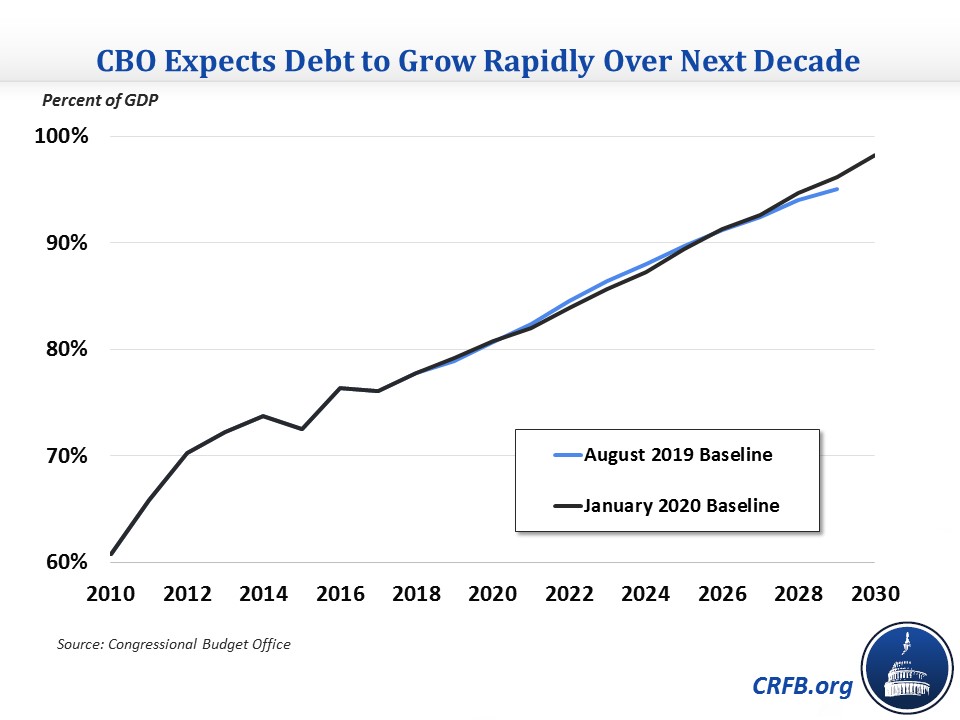CBO's Budget Projections Show Deteriorating Fiscal Outlook
The Congressional Budget Office (CBO) just released its latest Budget and Economic Outlook, which shows trillion-dollar deficits returning permanently this year and projects high and rising debt and deficits over the next decade and beyond. Under current law, CBO projects debt to rise from $17.2 trillion today to $31.4 trillion by 2030, a $14.3 trillion increase. As a share of the economy, debt will grow from 80 percent of Gross Domestic Product (GDP) today to 98 percent of GDP by 2030 and 180 percent of GDP by 2050. Deficits are expected to surpass the trillion-dollar mark this year and continue thereafter, reaching an unprecedented $1.7 trillion (and rarely seen 5.4 percent of GDP) in 2030.

Rising debt and deficits are driven by a disconnect between spending and revenue. Under current law, spending is expected to grow from 21 percent of GDP in 2019 to 23.4 percent by 2030. Revenues, meanwhile, will increase from 16.3 percent of GDP in 2019 to 17.1 percent by 2025, then jump to 18 percent for 2027-2030 after the individual tax cuts in the 2017 tax law expire in 2026.
CBO’s projections have slightly deteriorated since its last baseline projection in August. In total, CBO projects 2020-2029 deficits totaling $12.4 trillion, a $160 billion increase from its previous estimate of $12.2 trillion. As a result, CBO expects debt to reach 96 percent of GDP in 2029, compared to its prior estimate of 95 percent. Similarly, the annual deficit will be 4.8 percent of GDP in 2029, 0.3 percentage points higher than the August 2019 projection of 4.5 percent. The higher deficits in CBO's current projection are due to the appropriations deal signed into law this past December that extended several tax cuts and cost $500 billion, while economic changes reduce deficits by $705 billion and technical changes increase them by $360 billion. The economic changes are largely due to higher revenue and lower interest rates, while the technical changes come from lower individual income tax revenue and higher Medicare spending.
Changes in CBO's Baseline Budget Projections
| Source of Change | 2020-2029 |
|---|---|
| August 2019 Baseline Projections | $12.2 trillion |
| Legislative Changes | $505 billion |
| Economic Changes | -$705 billion |
| Technical Changes | $360 billion |
| January 2020 Baseline Projections | $12.4 trillion |
| Change in Baseline Deficits | $160 billion |
Source: Congressional Budget Office. All numbers include debt service.
CBO projects economic growth slightly above 2 percent this year but expects it to taper down to 1.9 percent in 2021 and 1.5 to 1.7 percent later in the decade. Meanwhile, inflation, unemployment, and interest rates are projected to increase modestly through 2030 from their current levels.
Lawmakers need to address our nation's budgetary challenges sooner rather than later. The first step toward getting our fiscal house in order is to stop making the situation worse by offsetting the costs of new proposals, curbing the growth of health costs, increasing revenue, reducing spending, and pursuing a pro-growth economic agenda.
The Committee for a Responsible Federal Budget will release its full analysis of CBO's projections later today.


